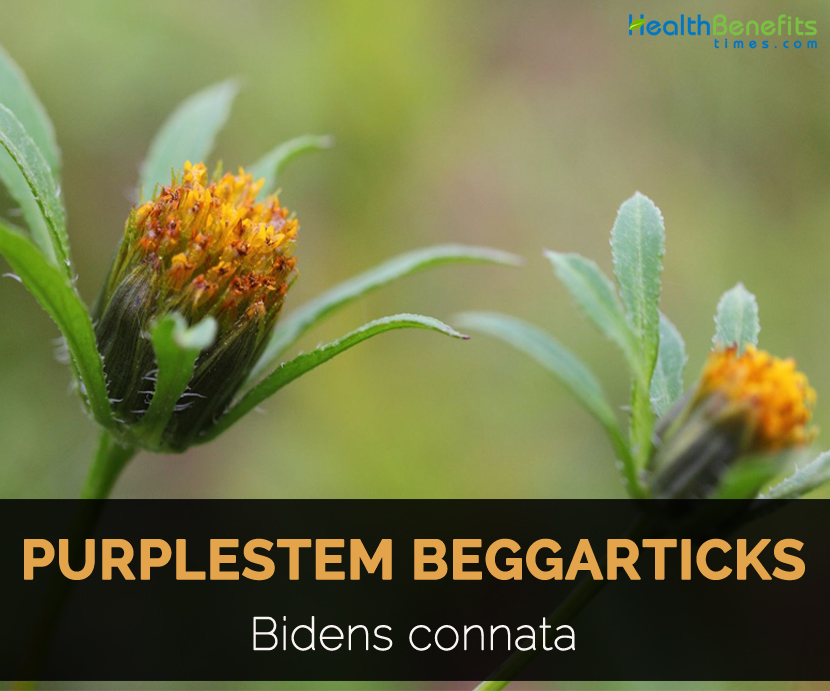| Purplestem beggarticks Quick Facts | |
|---|---|
| Name: | Purplestem beggarticks |
| Scientific Name: | Bidens connata |
| Origin | It is widespread across much of Eurasia, North Africa, and North America, and naturalized in Australia and on certain Pacific Islands. |
| Name | Purplestem beggarticks |
|---|---|
| Scientific Name | Bidens connata |
| Native | It is widespread across much of Eurasia, North Africa, and North America, and naturalized in Australia and on certain Pacific Islands. |
| Common/English Name | Cockhold Herb, Spanish Needles, Beggar’s Tick, Devil’s Pitchfork, London bur-marigold |
| Name in Other Languages | French: Bident soudé, Bident à feuilles connées, Bident cone; English: London Bur-marigold, Purplestem beggarticks, Purple-stemmed beggarticks, Swamp beggars’ ticks, Connate beggarticks, Purple-stemmed swamp beggarticks, Purple-stemmed tickseed |
| Plant Size | 200 cm (80 inches) tall |
| Stem | Light green to purple, glabrous |
| Leaf | Lanceolate, opposite, serrate, acuminate |
| Flower | Yellow |
| Medicinal part | The herb |
Uses
Dr. Brown (1857) “The root and seeds are emmenagogue and expectorant; the seeds, in powder or tincture have been used in amenorrhoea, dysmenorrhoea, and some other uterine derangements, and an infusion of the root has proved beneficial in severe cough.” It has been used with great success for palpitation of the heart and for croup. For the latter affliction a strong infusion of the leaves sweetened with honey and administered in tablespoonful doses every 15 min. until vomiting is produced is regarded as a cure. The leaves, heated to the form of a poultice and laid upon the throat and chest in cases of bronchial and laryngeal attacks from exposure to cold, etc, are very beneficial.
Dose
1 teaspoonful of the root, cut small or granulated, to 1 cupful of boiling water. Drink cold 1 cupful during the day, a large mouthful at a time. Of the tincture, 5–20 drops. Either Bidens bipinnata (Spanish needles) or Bidens frondosa (Beggar’s tick) can be employed, both having the same medical properties.
Russian Experience
A variety of Bidens grow throughout Russia. Chereda (Bidens triparita) has the most attention medicinally and commercially. The well-dried leaves keep their natural colour, have specific aroma and astringent, slightly bitter taste.
Folk Medicine employed the silent qualities of Chereda long before words were expressed on paper. Decoctions were used for tension of fear, blood purifying, liver trouble, colds, inflammation of the bladder, headache, eczema (internally as tea, decoction, extracts), external bathing for skin irritations, nervous upset children to induce sleep (Bello-Russ. Academy of Science, Minsk, 1965). Tea used for scrofula, rickets, diathesis, gout and as a diuretic and diaphoretic. For improved metabolism, 1 tablespoonful to 1 cupful of boiling water, steeped 10 min. and strained. Dose, 1 tablespoonful eight times a day (Moscow University, Moscow, 1963).
Clinical
In the form of Nastoika, extracts and decoctions in combinations of compounds for treatment of internal and external ailments. Pharmacopeia of late has given attention to Bidens triparita.
Industrial
The wild collection of Bidens falls short of the demand. Cultivation is very successful: they seed 12–14 lb. per acre and harvest up to 2,500 lb. of dry herb. Cutting starts just before the buds flower and when the plant is about 50 cm. high, using only the leaves and tops.
Commercial
Beautiful cream shades of brown, orange and yellow are used for dying wool and silk.
Medicinal uses
- It is used for inflammation, bleeding, pain of urinary tract mucosa and used for benign prostatic hypertrophy and increasing excretion of uric acid and decreases the chances of gout attacks.
- It is used in Chinese medicine for diarrhea, bug bites and snakebite.
- Use it in folk medicine for debility, appendicitis, furunculosis, earache, dysuria, hemorrhage, gravel, jaundice, hypertension, tabes and rheumatism.
- Cherokee use the leaf tea to expel worms.
- Chew the leaves for sore throat.
- Use the juice as eardrops.
- Use the seeds in form of tincture or powder for amenorrhoea, dysmenorrhea.
- Root infusion is helpful for severe cough.
- Use it for heart palpitation and croup.
- Heat the leaves to make a poultice and put it on throat and chest for bronchial and laryngeal attacks from exposure to cold.
References:
https://plants.usda.gov/core/profile?symbol=BICO5
https://www.minnesotawildflowers.info/flower/purple-stem-beggarticks
http://earthnotes.tripod.com/beggartick.htm
https://davesgarden.com/guides/pf/go/162510/#b
Comments
comments
